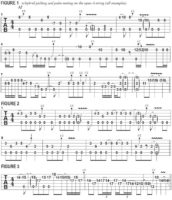
Expanding on Drone-Based Ideas for Riffs and Solos
In this final installment of our examination of drone-based ideas, I’d like to demonstrate how one can apply position shifts in conjunction with the droning technique to broaden the melodic possibilities of a given lick or phrase.
Once again, we’ll use a constant open-string drone as the root note, which serves to provide a repeating reference to the tonic, or “home key,” as a harmonic frame of reference. In these examples, I’ll use the open A string, and the melodic lines will be based on the A minor pentatonic scale (A C D E G) with brief reference to the A blues scale (A C D Eb E G).
FIGURE 1 begins with melodic lines based on A minor pentatonic played in fifth position. In order to strengthen the reference to A7 and the dominant-seven sound, most of the minor thirds, C in the key of A, are bent up slightly toward C#, making reference to the major third, which, in conjunction with the minor, or “flatted,” seventh, G, conveys an A dominant-seven tonality. Keep in mind that the chord tones of A7 are A, C# E and G.
These four chord tones will carry the most weight melodically, so starting or stopping on any of them will always sound good. Allotting for the C-to-C# trade-off, the only note in the A minor pentatonic scale that is not a chord tone is D, the fourth of A. If one were to simultaneously sound a C# and a C, octaves apart, the C note, normally designated as the minor third, is thought of as a sharp nine (#9) because the third of the chord is represented as major with the presence of C#.
In order to repeatedly pick the open A string drone while simultaneously playing a melodic line on the higher strings, I employ hybrid picking, flatpicking all of the open A notes and fingerpicking the majority of the melodic notes on the higher strings. This technique approach is a staple of country and acoustic blues guitar playing and is a technique that’s also widely exploited by electric blues players.
Another important element in the pick attack involves slight palm-muting of the open-string drone: lightly rest the edge of your pick-hand palm across the lower strings next to the bridge saddles to achieve a “choked,” percussive sound, while allowing all of the higher strings to ring as clearly as possible. In bar 9, I use a “rolling” picking technique to sound the fifth, third and first strings in quick succession, low to high.
In FIGURE 2, I move the melodic phrase down to second/third position, which serves to emulate an “open A tuning” type of sound, used to great effect by blues guitar legend John Lee Hooker. A great way to expand on the way in which these melodic phrases fall on the fretboard is to simply move them up an octave to 14th/15th position, as illustrated in FIGURE 3. You’ll hear this kind of expanded approach in the playing of ZZ Top’s Billy Gibbons, a player whose style is greatly influenced by Hooker, as exemplified by the classic ZZ Top track “La Grange.”
Source: www.guitarworld.com









